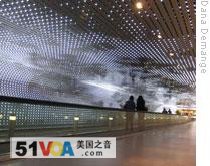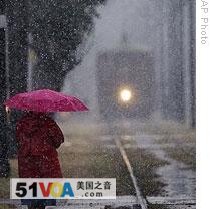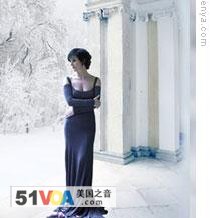2008-12-18
HOST:
Welcome to AMERICAN MOSAIC in VOA Special English.
(MUSIC)
I'm Doug Johnson. This week:
We listen to holiday music ...
Answer a listener question about snowfall in the United States ...
And, report about some special lights at a museum that help make the season bright, even underground.
(MUSIC)
Leo Villareal's Light Sculpture
HOST:
During the Christmas season in Washington, D.C., you can see bright lights on many homes, buildings and trees. A new work at the National Gallery of Art is adding to this magical season of lights. Artist Leo Villareal has created an artwork with forty-one thousand small flashing lights. "Multiverse" gives museum visitors an exciting way to see and experience art. Barbara Klein tells us more.
BARBARA KLEIN:
Leo Villareal is known for making art that inventively combines light and computer programming. About three years ago, the National Gallery of Art asked him to design a light sculpture for the underground passage connecting the museum's two buildings. His work, called "Multiverse," opened in November.
He transformed the wall and ceiling of the sixty-meter long area into a surface made up of thousands of blinking lights. These very small lights are called light-emitting diodes, or L.E.Ds.
 |
| "Multiverse" by Leo Villareal |
Leo Villareal designed a computer program that controls the lights. He first began exploring light, sound and video while he was studying theater design and sculpture at Yale University in Connecticut. He later continued his studies in new media and computing in art school at New York University. He lives in New York City.
Mister Villareal has designed other light sculptures for the inside and outside of buildings. But "Multiverse" is his largest and most complex project so far. The work will remain at the National Gallery until November of next year.
(MUSIC)
Winter Weather
HOST:
Our VOA listener question comes from Shenzhen, China. Simbo wants to know about snowfall and winter storms in the United States.
 |
| Snow falling last week on New Orleans, Louisiana |
In the far northern part of the country, Americans have battled deep snow and powerful winds. Such blizzards are common in the area known as the Great Plains of South Dakota and North Dakota. Minnesota also got hit. Temperatures were far below freezing. And the wind has made the snow blow so hard and fast that it was sometimes impossible to see.
In the northeastern United States, people are facing another kind of winter problem. Last week, the New England states were hit by a terrible ice storm. Hundreds of thousands of people were forced to leave their homes because of power outages. Tens of thousands remain without power in the states of New Hampshire, Maine, Massachusetts and New York.
Around the nation, there are reports of at least ten weather related deaths. And winter is just beginning. Snow and other winter weather cause hundreds of deaths in the United States every year. Traffic accidents on snowy or icy roads cause many of them. Other deaths are the result of severe cold or heart attacks from extreme physical activity like clearing snow.
Winter storms can be dangerous. People should stay in their homes during snow storms. They should take short rests while clearing snow. And people should have supplies like extra blankets, water, food and special power devices before a storm hits. You can learn more about snow on the Special English program Science in the News on December thirtieth.
Christmas Music
(MUSIC)
HOST:
African beats, jazzy rhythms and country guitars can be found among the sounds of the new Christmas albums this year. So can voices clear as a Christmas bell, smooth as new snow and sweet as a candy cane.
Steve Ember tells about some of the new musical offerings and plays a few tunes as well.
(MUSIC)
 |
| Enya |
That is the Irish singer, Enya, singing "Spirit of Christmas Past" from her new album, "And Winter Came." Most of the songs have that slow, calm rhythm and the sound of new age music.
Not at all true of this next song. The traditional song, "Sleigh Ride," is faster and more fun than ever on Bela Fleck and the Flecktones' new album, "Jingle All the Way."
(MUSIC)
Jazz/pop singer Ledisi also has a new Christmas album. She sings some traditional songs but also helped write some new ones. This one is the album's title track, "It's Christmas."
(MUSIC)
Country singer George Strait's album, "Classic Christmas," is very traditional. Here the superstar sings an all-time favorite, "Joy to the World."
(MUSIC)
We leave you now with Bela Fleck and the Flecktones performing "The Christmas Song."
(MUSIC)
HOST:
I'm Doug Johnson. I hope you enjoyed our program today.
It was written by Dana Demange and Caty Weaver, who was also the producer. To read the text of this program and download audio, go to our Web site, 51voa.com.
Join us again next week for AMERICAN MOSAIC, VOA's radio magazine in Special English.